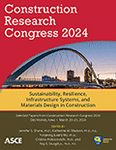Does LEED BD+C for New Construction Provide a Realistic and Practical Sustainability Evaluation System?
Publication: Construction Research Congress 2024
ABSTRACT
Leadership in Energy and Environmental Design (LEED) provides valuable criteria for evaluating the sustainability of construction projects. However, it is not clear if in this point-based system, the evaluation credits are realistically and practically developed and weighted. To understand this, all the LEED-NC (v4) certified projects in the US were investigated (n = 797). The data was collected from the US Green Building Council (USGBC) website. A model was developed based on the predefined relationships between credit categories and the overall LEED scores. After validating the model through confirmatory factor analysis (CFA), the actual contribution of each credit category to the overall sustainability level was evaluated through structural equation modeling (SEM). The expected and actual contributions were then compared. The results showed that the expected contributions of the credit categories are not consistent with the actual influences thus demonstrating the need for redefining some of the credits and their corresponding weights.
Get full access to this article
View all available purchase options and get full access to this chapter.
REFERENCES
Awang, Z. 2012. Research Methodology and Data Analysis Second Edition - Zainudin Awang - Google Books.
Beauducel, A., and W. W. Wittmann. 2005. “Simulation study on fit indexes in CFA based on data with slightly distorted simple structure.” Struct. Equ. Model., 12 (1): 41–75. Routledge. https://doi.org/10.1207/s15328007sem1201_3.
Cheng, J. C. P., and L. J. Ma. 2015. “A data-driven study of important climate factors on the achievement of LEED-EB credits.” Build. Environ., 90: 232–244. Pergamon. https://doi.org/10.1016/J.BUILDENV.2014.11.029.
Ferreira, A., M. D. Pinheiro, J. de Brito, and R. Mateus. 2023. “A critical analysis of LEED, BREEAM and DGNB as sustainability assessment methods for retail buildings.” J. Build. Eng., 66 (July 2022): 105825. Elsevier Ltd. https://doi.org/10.1016/j.jobe.2023.105825.
Finney, S. J., and C. DiStefano. 2013. “Non-normal and categorical data in structural equation modeling.” Struct. Equ. Model. A Second course, 269–314.
Greer, F., J. Chittick, E. Jackson, J. Mack, M. Shortlidge, and E. Grubert. 2019. “Energy and water efficiency in LEED: How well are LEED points linked to climate outcomes?” Energy Build., 195 (October 2017): 161–167. Elsevier B.V. https://doi.org/10.1016/j.enbuild.2019.05.010.
Hooper, D., J. Coughlan, and M. R. Mullen. 2008. “Structural Equation Modelling: Guidelines for Determining Model Fit.” Electron. J. Bus. Res. Methods, 6 (1): 53–60.
Kenny, D. A., and D. B. McCoach. 2003. “Effect of the Number of Variables on Measures of Fit in Structural Equation Modeling.” Struct. Equ. Model., 10 (3): 333–351. https://doi.org/10.1207/S15328007SEM1003_1.
Kim, J. M., K. Son, and S. Son. 2020. “Green benefits on educational buildings according to the LEED certification.” Int. J. Strateg. Prop. Manag., 24 (2): 83–89. Vilnius Gediminas Technical University. https://doi.org/10.3846/IJSPM.2020.11097.
Kline, R. B. 1998. Principles and Practice of Structural Equation Modeling, Second Edition. Methodol. Soc. Sci.
Satorra, A., and P. M. Bentler. 2001. “A scaled difference chi-square test statistic for moment structure analysis.” Psychometrika, 66 (4): 507–514. Psychometric Society. https://doi.org/10.1007/BF02296192.
Schreiber, J. B., F. K. Stage, J. King, A. Nora, and E. A. Barlow. 2006. Reporting Structural Equation Modeling and Confirmatory Factor Analysis Results: A Review.
Wu, P., C. Mao, J. Wang, Y. Song, and X. Wang. 2016. “A decade review of the credits obtained by LEED v2.2 certified green building projects.” Build. Environ., 102: 167–178. Elsevier Ltd. https://doi.org/10.1016/J.BUILDENV.2016.03.026.
Wu, P., Y. Song, W. Shou, H. Chi, H. Y. Chong, and M. Sutrisna. 2017. “A comprehensive analysis of the credits obtained by LEED 2009 certified green buildings.” Renew. Sustain. Energy Rev., 68 (August 2016): 370–379. Elsevier. https://doi.org/10.1016/j.rser.2016.10.007.
Information & Authors
Information
Published In
History
Published online: Mar 18, 2024
Authors
Metrics & Citations
Metrics
Citations
Download citation
If you have the appropriate software installed, you can download article citation data to the citation manager of your choice. Simply select your manager software from the list below and click Download.
